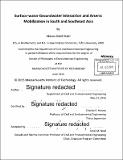Surface-water groundwater interaction and arsenic mobilization in south and southeast Asia
Author(s)
Stahl, Mason Odell
DownloadFull printable version (26.16Mb)
Other Contributors
Massachusetts Institute of Technology. Department of Civil and Environmental Engineering.
Advisor
Charles F. Harvey.
Terms of use
Metadata
Show full item recordAbstract
Contamination of groundwater with geogenic arsenic is widespread throughout much of South and Southeast Asia and poses a serious health risk to the millions of individuals who consume this water. It is widely agreed that the dominant mechanism of arsenic mobilization is reductive dissolution of arsenic-bearing iron-oxides coupled to the oxidation of organic carbon. However, it is unclear why dissolved arsenic concentrations have reached the high levels currently observed in aquifers throughout the region. In particular, the influence of surface water recharge on arsenic contamination remains unresolved. To address this issue we studied the hydrogeology and geochemistry of two arsenic contaminated sites: one site in Vietnam and another site in Bangladesh. Our field site in Vietnam is located adjacent to the Red River and has been impacted by intensive groundwater pumping for decades. The aquifer now receives net recharge from the river. We conducted a hydrogeologic and geochemical investigation to determine the influence of riverine recharge on groundwater arsenic concentrations. We determined that rates of arsenic mobilization in freshly deposited riverbed sediments are up to 1000 times those of inland aquifer sediments and measured arsenic concentrations in riverbed porewaters that exceeded the aquifer concentrations. We found the effect of riverine recharge is controlled by the geomorphic setting of the river-aquifer interface. Aquifers inland of freshly deposited river reaches are highly contaminated with dissolved arsenic, whereas aquifers inland of non-depositional river reaches host low arsenic groundwater. At our Bangladesh field site the aquifer has been impacted by the construction of man-made ponds, which provide 40% of aquifer recharge. To investigate the role of ponds on groundwater arsenic levels we constructed and instrumented a pond, installed a network of 100 wells, performed laboratory experiments, and collected sediment and water samples over three years. Our characterization of the pond physical hydrology and the pond and aquifer geochemistry reveals that arsenic mobilization within the aquifer is primarily driven by sedimentary organic matter. While ponds contribute substantial aquifer recharge our results suggest that high arsenic concentrations in Bangladesh are not driven by surface water recharge and likely emerged prior to anthropogenic perturbations to the hydrology.
Description
Thesis: Ph. D. in Environmental Engineering, Massachusetts Institute of Technology, Department of Civil and Environmental Engineering, 2015. Cataloged from PDF version of thesis. Includes bibliographical references.
Date issued
2015Department
Massachusetts Institute of Technology. Department of Civil and Environmental EngineeringPublisher
Massachusetts Institute of Technology
Keywords
Civil and Environmental Engineering.